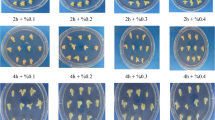Abstract
Mutation experiments require careful selection of a mutagen with characteristics suited to the tissue source and mutagenesis objective, and an appropriate treatment regime. The objectives of the present investigation were:-to compare the ability of immature embryos to initiate calluses and calluses derived from immature embryos to survive and grow after being treated with ethyl methanesulfonate (EMS) doses of 0.2, 0.4, 0.8, 1.2, and 1.6% (v/v) and-to compare these results with those published for seed mutagenesis. To determine if the response of tissue source to EMS treatment varied with genotype, tissues from two spring wheat cultivars, ‘Angus’ and ‘Pavon 76’, were used. The combined analysis of variance detected highly significant differences (p≤0.01) among doses. The higher the dose, the lower the tissue survival in each tissue source. No significant differences were detected between cultivars, tissue sources, in the cultivar by dose interaction, tissue source by dose interaction, tissue source by cultivar interaction, or tissue source by cultivar by dose interaction. Hence, both cultivars and tissue sources responded similarly to EMS doses. The predicted LD20 are 0.35%±0.08% for the immature embryo treatment, and 0.36%±0.10% for the callus treatment. The predicted LD50 are 0.82%±0.13% for the immature embryo treatment, and 0.77%±0.13% for the callus treatment. These results were very similar to published results for seed mutagenesis, hence seed mutagenesis research may be applicable to immature embryo and callus mutagenesis.
Similar content being viewed by others
References
Baenziger PS (1988) Biotechnology and mutation breeding. In: Semidwarf Cereal Mutants and their Use in Cross Breeding. III (pp 9–14). IAEA-Tecdoc-455. Vienna, Austria
Baenziger PS, Wesenberg DM, Smail VM, Alexander WL & Schaeffer GW (1989) Agronomic performance of wheat double haploid lines derived from cultivars by anther culture. Plant Breeding. 103: 101–109
Cocking EC (1978) Prospects for the future: Cell culture. In: Seed Protein Improvement in Cereals and Grain Legumes, Vol II (pp 395–402). IAEA, Vienna, Austria
Eapen S & Rao PS (1986) Spontaneous and induced variation in tissue cultures and regenerated plants of bread-wheat. In: Withers LA & Alderson PG (Eds) Plant Tissue Culture and Its Agricultural Applications (pp 461–467). Butterworths, London, UK
Gao MW, Liang ZG & Chen ZY (1988) Effect of gamma radiation on immature wheat embryo culture. In: Semi Dwarf Cereal Mutants and their use in Cross Breeding III (pp 177–182). IAEA, Vienna, Austria
IAEA (1977) Manual on mutation breeding, second ed. Tech. Report Series no. 119. Vienna, Austria
Karp A & Bright SWJ (1985) On the causes and origins of somaclonal variation. Oxford Surv. Plant. Mol. Cell Biol. 2: 199–234
Konzak CF (1981) Induced mutations for genetic analyses and improvement wheat. IAEA-SM-251/53. In: Induced Mutations—a Tool in Plant Research (pp 469–488). STI/PUB/591. Vienna, Austria
Konzak CF, Nilan RA, Wagner J & Foster RJ (1965) Efficient chemical mutagenesis. In: The use of induced Mutations in Plant Breeding. Suppl. to Rad. Bot. Vol 5 (pp 49–70). FAO/IAEA Tech. meeting. Pergamon Press, London, UK
Larkin PJ (1987) Somaclonal variation: history, method, and meaning. Iowa State J. Res. 61: 393–439
Larkin PJ & Scowcroft WR (1981) Somaclonal variation — A novel source of variability from cell cultures for plant improvement. Theor. Appl. Genet. 60: 197–214
Maddock SE, Lancaster VA, Risiott R & Franklin J (1983) Plant regeneration from cultured immature embryos and inflorescences of 25 cultivars of wheat (Triticum aestivum). J. Exp. Bot. 34: 915–926
Moustafa RAK, Duncan DR & Widholm JM (1989) The effect of gamma radiation and N-ethyl-N-nitrosourea on cultured maize callus growth and plant regeneration. Plant Cell Tiss. Org. Cult. 17: 121–132
Müntzing A & Bose S (1969) Induced mutation in inbred lines of rye. I. EMS treatments. Hereditas. 62: 382–408
Murashige T & Skoog F (1962) A revised medium for rapid growth and bioassays with tobacco tissue cultures. Physiol. Plant. 15: 473–497
Ozias-Akins P & Vasil IK (1982) Plant regeneration from cultured immature embryos and inflorescences of Triticum aestivum L. (Wheat): evidence for somatic embryogenesis. Protoplasma. 110: 95–105
Rao HKS & Sears ER (1964) Chemical mutagenesis in Triticum aestivum. Mutat. Res. 1: 387–399
SAS (1985) SAS User's guide: Statistics. SAS Institute Inc., Cary, North Carolina, USA
Sears RG & Deckard EL (1982) Tissue culture variability in wheat: Callus induction and plant regeneration. Crop Sci. 22: 546–550
Sheppard SC, Alder V, Evenden WG & Rossnagel BG (1989) Relationship between seed vigour and sensitivity to ionizing radiation. Seed Sci. & Tech. 17: 205–222
Shimada T (1978) Plant regeneration from the callus induced from wheat embryo. Jpn. J. Genet. 53: 371–374
Shimada T & Yamada Y (1979) Wheat plants regenerated from embryo cell cultures. Jpn. J. Genet. 54: 379–385
Steel RGD & JH Torrie (1980) Principle and Procedures of Statistics: A Biometrical Approach, 2nd edition. McGraw-Hill Book Co. Inc., New York, USA
Walles S (1967) Studies on the uptake of ethyl methanesulfonate into embryos of barley. Hereditas. 58: 95–102
Yonezawa K & Yamagata H (1977) On the optimum mutation rate and optimum dose for practical mutation breeding. Euphytica. 26: 413–426
Author information
Authors and Affiliations
Additional information
Published as paper No. 9241 journal series, Nebraska Agric. Res. Div.
Rights and permissions
About this article
Cite this article
Masrizal, Simonson, R.L. & Baenziger, P.S. Response of different wheat tissues to increasing doses of ethyl methanesulfonate. Plant Cell Tiss Organ Cult 26, 141–146 (1991). https://doi.org/10.1007/BF00039935
Received:
Accepted:
Issue Date:
DOI: https://doi.org/10.1007/BF00039935




